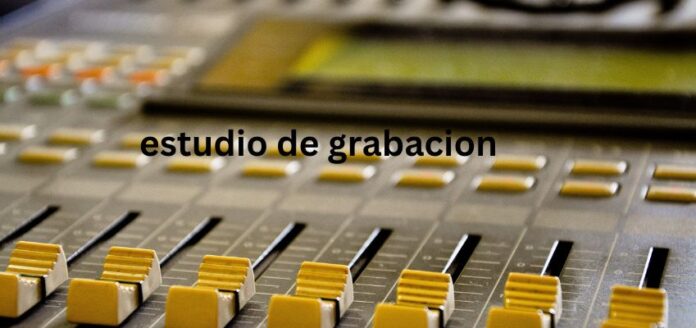Introduction to estudio de grabacion
Welcome to the world of estudio de grabacion, where music comes to life and melodies are immortalized! If you’ve ever wondered how your favorite songs are brought to fruition, then this blog post is for you. Whether you’re an aspiring musician or simply curious about the magic behind studio recordings, we’re here to unravel the mysteries and shed light on what goes on inside a recording studio.
From humble beginnings in the early days of audio technology to the state-of-the-art facilities we have today, recording studios have played a crucial role in shaping the music industry. So let’s dive into the history and evolution of these creative spaces before exploring their various types and essential equipment. And if you’ve ever dreamt of stepping foot inside a professional studio, stick around as we walk you through the steps involved in making your own musical masterpiece.
But first things first – what exactly is an estudio de grabacion? Well, it’s simply Spanish for “recording studio.” Now that we’ve got that covered, let’s embark on a journey through time and space as we explore everything there is to know about these magical places where dreams become sound waves!
The History of Recording Studios
Recording studios have come a long way since their inception. It all began in the late 19th century when Thomas Edison invented the phonograph, which allowed sound to be recorded and played back for the first time. This marked the beginning of a new era in music production.
In the early days, recording was done using large machines that used wax cylinders or vinyl discs to capture sound. These primitive recording devices were bulky and required careful handling to avoid damaging the fragile medium.
As technology advanced, so did recording studios. In the 1950s and 1960s, magnetic tape revolutionized the industry by offering higher quality recordings and easier editing capabilities. This led to major advancements in audio engineering techniques and paved the way for multi-track recording.
With digital technology taking over in recent years, recording studios have become even more powerful and versatile. Digital audio workstations (DAWs) now allow producers to manipulate sound with precision, creating endless possibilities for creativity.
Today’s recording studios are equipped with state-of-the-art equipment such as microphones, mixing consoles, monitors, and software plugins that enable artists and producers to achieve professional-grade recordings right from their own studio space.
The evolution of recording studios has not only transformed how music is created but also how it is consumed. With online streaming platforms like Spotify dominating the market, artists can reach a global audience without ever setting foot inside a traditional studio.
In conclusion
The history of recording studios showcases an incredible journey from humble beginnings to cutting-edge technology. These spaces have played a crucial role in shaping music production throughout history and continue to push boundaries today.
Types of Recording Studios
When it comes to recording music, there are different types of recording studios that cater to various needs and preferences. Each type offers its own unique set of features and benefits.
1. Home Studios: These are small-scale setups that musicians or producers have in their homes. They often consist of a computer, audio interface, microphone, and basic studio monitors. Home studios are convenient for artists who want to work at their own pace and budget-friendly for those starting out in the industry.
2. Project Studios: These studios are slightly larger than home setups but still relatively affordable. They offer more advanced equipment such as mixing consoles, outboard gear, and better acoustics. Project studios provide a comfortable environment for artists to record quality music without breaking the bank.
3. Commercial Studios: These professional-grade facilities are typically larger with multiple rooms dedicated to different stages of the recording process – tracking, mixing, mastering etc. Commercial studios boast top-of-the-line equipment including high-end microphones, preamps, analog gear, and spacious control rooms designed by experts in acoustics.
4. Mobile Recording Studios: As technology advances, so does convenience in recording music. Mobile recording studios allow musicians to record on location using portable equipment like laptops and compact interfaces while maintaining high-quality sound production.
Each type serves a specific purpose depending on the artist’s needs or project requirements; whether it’s producing demos at home or creating a polished album at a commercial facility!
Essential Equipment in a Recording Studio
When it comes to setting up a recording studio, having the right equipment is essential. The equipment you choose can greatly impact the quality and overall sound of your recordings. Here are some of the essential pieces of equipment you will find in a typical estudio de grabacion.
First and foremost, a good microphone is crucial. There are many different types of microphones available, each with its own unique characteristics and uses. From dynamic microphones for capturing vocals or instruments with high sound pressure levels, to condenser microphones known for their sensitivity and accuracy, choosing the right microphone for your needs is important.
Another key piece of equipment is an audio interface. This device connects your computer to the rest of your recording setup and converts analog audio signals into digital data that can be manipulated on your computer. A high-quality audio interface ensures clean and accurate recordings.
Of course, no recording studio would be complete without monitors or speakers. These allow you to accurately hear what you’re recording or mixing, ensuring that your final product sounds great across different playback systems.
In addition to these essentials, other equipment commonly found in recording studios include headphones for monitoring during tracking or mixing sessions, preamps for amplifying low-level signals from microphones or instruments before they reach the audio interface, and signal processors such as compressors or equalizers for shaping the sound during mixing.
The specific gear you choose will depend on factors such as budget, personal preference, and intended use of the studio space. It’s always a good idea to do thorough research before making any purchases to ensure that you invest in equipment that suits your needs.
Remember that this list only scratches the surface when it comes to all the possible tools available in a recording studio setup. As technology continues to advance at breakneck speed within this industry, new gadgets are being introduced regularly – enhancing workflow efficiency while pushing creative boundaries further than ever before! So keep exploring new possibilities and stay ahead of the game by constantly updating your equipment.
Steps to Recording in a Studio
Recording in a studio is an exciting and professional experience that can take your music to the next level. Whether you’re a seasoned musician or just starting out, following the right steps will ensure a successful recording session.
First, it’s important to plan ahead and be prepared. Before heading to the estudio de grabacion, make sure you have all your songs rehearsed and polished. This will save you time and money in the studio.
Next, choose the right recording engineer or producer who understands your musical style and vision. They will play a crucial role in capturing the sound you want.
Once inside the studio, take some time to get comfortable with your surroundings. Familiarize yourself with the equipment and layout of the space. This will help you feel more relaxed during recording sessions.
When it comes time to record, focus on delivering your best performance. Take advantage of multiple takes if needed but also trust yourself and don’t overthink every little detail.
After recording all tracks, it’s time for post-production work such as editing, mixing, and mastering. Collaborate closely with your engineer to achieve the desired sound quality for each track.
Listen back with fresh ears before finalizing any mix or master decisions. It’s essential to give yourself some distance from the recordings so that you can assess them objectively.
By following these steps while recording in a estudio de grabacion , you’ll have a smooth process that yields high-quality results for your music project!
Benefits of Using a Recording Studio
Benefits of Using a Recording Studio
When it comes to creating high-quality recordings, using a recording studio can offer numerous benefits. One of the main advantages is the availability of top-notch equipment and technology. Recording studios are equipped with state-of-the-art microphones, mixing consoles, digital audio workstations, and soundproof rooms that enable artists to capture their music in crystal-clear quality.
Another benefit is the expertise of studio engineers and producers who have extensive knowledge and experience in recording techniques. These professionals can provide valuable guidance on microphone placement, signal processing, and overall production to ensure that your recorded tracks sound professional.
Additionally, recording studios often offer acoustically treated spaces that eliminate unwanted noise and optimize sound quality. This ensures that every instrument or vocal track is captured accurately without any interference or background distractions.
Moreover, recording studios provide a collaborative environment where musicians can work together seamlessly. It allows for effective communication between band members as well as between the artist and engineer or producer. This fosters creativity and enhances the overall production process.
Furthermore, working in a dedicated space like a recording studio helps eliminate external distractions such as household noises or interruptions from outside sources. This enables artists to focus solely on their music without any disturbances.
Utilizing a recording studio gives artists access to professional-grade post-production services such as editing, mixing, mastering, and adding effects. These services help polish recordings to perfection before they are released for public consumption.
In conclusion,
recording studios provide an ideal setting for musicians looking to create high-quality recordings with expert assistance and top-of-the-line equipment.
The Future of Estudio de Grabacion
The future of Estudio de Grabacion is filled with exciting possibilities and advancements. As technology continues to evolve, recording studios are becoming more accessible and versatile than ever before.
One trend that we can expect to see in the future is the integration of virtual reality (VR) into recording studio experiences. Imagine being able to step into a virtual studio environment, where you can manipulate soundscapes and interact with digital instruments in ways never thought possible.
Another area of development is artificial intelligence (AI). AI has already made its mark on various industries, and the world of recording studios is no exception. AI-powered tools can assist with tasks such as audio editing, mixing, and mastering, making the production process faster and more efficient.
Additionally, we may see an increase in collaborative online platforms for remote recording sessions. With musicians often spread out across different locations, these platforms will allow artists to work together seamlessly without physical proximity limitations.
Furthermore, as sustainability becomes a growing concern globally, eco-friendly practices may become more prevalent in estudio de grabacion. This could involve using energy-efficient equipment or implementing recycling programs within the studio space.
In conclusion,
the future holds immense potential for Estudio de Grabacion
to continue pushing boundaries
and embracing new technologies
that will revolutionize the way music is recorded
and produced. Stay tuned for all the exciting developments that lie ahead!
Conclusion
In this blog post, we have explored the fascinating world of estudio de grabacion. We have delved into its history, discussed the different types of recording studios, and examined the essential equipment needed for a successful recording session. We have also walked through the steps involved in recording in a studio and highlighted the benefits of using a professional facility.
Estudio de grabacion has come a long way since its inception. From humble beginnings with basic equipment to state-of-the-art facilities equipped with cutting-edge technology, it has revolutionized the music industry. Recording studios offer artists an avenue to express their creativity and produce high-quality recordings that captivate audiences worldwide.
The future of estudio de grabacion looks promising as advancements in technology continue to enhance the capabilities of these facilities. With virtual reality experiences on the rise and remote collaboration becoming more commonplace, recording studios are evolving to meet changing demands while maintaining their commitment to delivering superior sound quality.
Whether you’re an aspiring musician or an established artist looking for professional-grade recordings, estudio de grabacion provides an environment where your musical vision can be brought to life. So why settle for mediocre when you can strive for excellence?
Embrace the power of estudio de grabacion and unlock your full potential as a musician. Step into a world where creativity knows no bounds, where every note is captured perfectly, and let your music resonate with listeners around the globe.
It’s time to make your mark in the ever-evolving landscape of music production – visit a estudio de grabacion today! Click here


